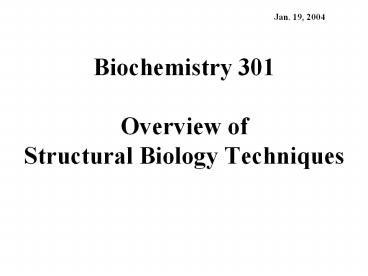Biochemistry 301 Overview of Structural Biology Techniques - PowerPoint PPT Presentation
1 / 25
Title:
Biochemistry 301 Overview of Structural Biology Techniques
Description:
A cell is an organization of millions of molecules ... Visualization of chemical properties to infer biological function (e.g. surface properties) ... – PowerPoint PPT presentation
Number of Views:79
Avg rating:3.0/5.0
Title: Biochemistry 301 Overview of Structural Biology Techniques
1
Biochemistry 301Overview of Structural Biology
Techniques
Jan. 19, 2004
2
Biological Structure
Sequence
Structural Scales
MESDAMESETMESSRSMYNAMEISWALTERYALLKINCALLMEWALLYIP
REFERDREVILMYSELFIMACENTERDIRATVANDYINTENNESSEEILI
KENMRANDDYNAMICSRPADNAPRIMASERADCALCYCLINNDRKINASE
MRPCALTRACTINKARKICIPCDPKIQDENVSDETAVSWILLWINITALL
polymerase
SSBs
Complexes
helicase
primase
Assemblies
Cell Structures
System Dynamics
3
High Resolution Structural Biology
Organ ? Tissue ? Cell ? Molecule ? Atoms
- A cell is an organization of millions of
molecules - Proper communication between these molecules is
essential to the normal functioning of the cell - To understand communication Determine
the Arrangement of Atoms
4
High Resolution Structural Biology
- Determine atomic structure
- Analyze why molecules interact
5
The Reward Understanding?Control
Shape
6
The Context of Atomic Structure
Molecule Structural Genomics Pathway Structural Proteomics Activity Systems Biology
7
The Strategy of Atomic Resolution Structural
Biology
- Break down complexity so that the system can be
understood at a fundamental level - Build up a picture of the whole from the
reconstruction of the high resolution pieces - Understanding basic governing principles enables
prediction, design, control - Pharmaceuticals, biotechnology
8
Approaches to Atomic Resolution Structural Biology
- NMR Spectroscopy X-ray
Crystallography - Computation
Determine experimentally or model 3D structures
of biomolecules Use Cryo-EM, ESR, Fluorescence
to build large structures from smaller pieces
9
Experimental Determination of 3D Structures
10
Uncertainty and Flexibility inX-ray
Crystallography and NMR
11
Computational Problems3D Structure From Theory
- Molecular simulations
- Structure calculations (from experimental data)
- Simulations of active molecules
- Visualization of chemical properties to infer
biological function (e.g. surface properties) - Prediction of protein structure (secondary only,
fold recognition, complete 3D)
12
Molecular Simulation
- Specify the forces that act on each atom
- Simulate these forces on a molecule and the
responses to changes in the system - Can use experimental data as a guide or an
approximate experimental structure to start - Many energy force fields in use all require
empirical treatment for biomacromolecules
13
Protein Structure PredictionWhy Attempt It?
- A good guess is better than nothing!
- Enables the design of experiments
- Potential for high-throughput
- Crystallography and NMR dont always work!
- Many important proteins do not crystallize
- Size limitations with NMR
14
Structure Prediction Methods
1 QQYTA KIKGR 11 TFRNE KELRD 21 FIEKF KGR
Algorithm
- Secondary structure (only sequence)
- Homology modeling
- Fold recognition
- Ab-initio 3D prediction The Holy Grail
15
Homology Modeling
- Assumes similar (homologous) sequences have very
similar tertiary structures - Basic structural framework is often the same
(same secondary structure elements packed in the
same way) - Loop regions differ
- Wide differences, even among closely related
proteins
16
Ab-Initio 3D Prediction
- Use sequence and first principles of protein
chemistry to predict 3D structure - Need method to score (energy function) protein
conformations, then search for the conformation
with the best score. - Problems scoring inexact, too many conformations
to search
17
Complementarity of the Methods
- X-ray crystallography- highest resolution
structures faster than NMR - NMR- enables widely varying solution conditions
characterization of motions and dynamic, weakly
interacting systems - Computation- fundamental understanding of
structure, dynamics and interactions (provides
the why answers) models without experiment very
fast
18
Challenges for Interpreting3D Structures
- To correctly represent a structure (not a model),
the uncertainty in each atomic coordinate must be
shown - Polypeptides are dynamic and therefore occupy
more than one conformation - Which is the biologically relevant one?
19
Representation of Structure Conformational
Ensemble
- Neither crystal nor solution structures can be
properly represented by a single conformation - Intrinsic motions
- Imperfect data
Uncertainty RMSD of the ensemble
20
Representations of 3D Structures
Precision is not Accuracy
21
Challenges for Converting3D Structure to Function
- Structures determined by NMR, computation, and
X-ray crystallography are static snapshots of
highly dynamic molecular systems - Biological process (recognition, interaction,
chemistry) require molecular motions (from
femto-seconds to minutes) - New methods are needed to comprehend and
facilitate thinking about the dynamic structure
of molecules visualization
22
Visualization of Structures
Intestinal Ca2-binding protein!
- Need to incorporate 3D and motion
23
Center for Structural BiologyThe Concept
Integrate the application of X-ray
crystallography, NMR, computational and other
complementary structural approaches to biomedical
problems
24
Center for Structural BiologyFacilities
- X-ray crystallography
- Local facilities (generator detectors)
- Synchrotron crystallography
- NMR
- Biomolecular NMR Center (2-500, 2-600, 800)
- Computation/Graphics
- Throughput computing clusters
- Resource Center Graphics Laboratory
25
Center for Structural BiologyA Resource
- Education and project origination
- Open-access (BIOSCI/MRBIII- 5th floor)
- Expertise (Laura Mizoue, Jarrod Smith Joel
Harp- Xray Jaison Jacob-NMR) - Access to instrumentation to determine and
visualize structures - Biophysical characterization- CD, fluorescence,
calorimetry































